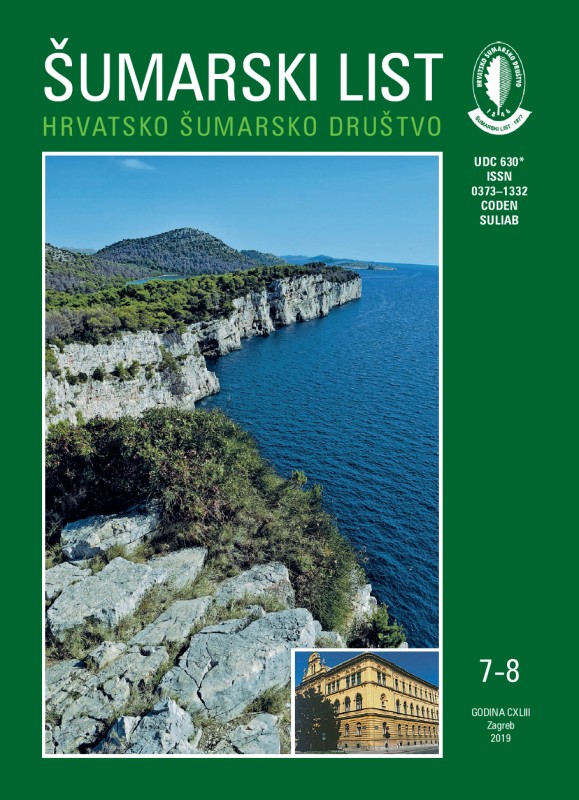
broj: 7-8/2019
pdf (13,1 MB) |
|
||||||||||||||
| RIJEČ UREDNIŠTVA | ||
| Uredništvo | ||
| Civil initiative to engage in collective tree planting on October 25, 26 and 27 pdf HR EN | 293 | |
| IZVORNI ZNANSTVENI ČLANCI | ||
| Joso Vukelić, Irena Šapić, Giacomo Mei, Igor Poljak, Ivana Plišo Vusić, Marko Orešković | UDK 630* 181.6 + 272 (001) https://doi.org/10.31298/sl.143.7-8.1 | |
| Black alder forests (type 91E0* Natura 2000 type E.2.1.9. NHC) in the Plitvice Lakes National Park pdf HR EN | 295 | |
| A. Paletto, T. Laktić, S. Posavec, Z. Dobšinská, B. Marić, I. Đordjević, P. Trajkov, E. Kitchoukov, Š. Pezdevšek Malovrh | UDK 630* 907 + 585 (001) https://doi.org/10.31298/sl.143.7-8.2 | |
| Nature conservation versus forestry activities in protected areas - the stakeholders’ point of view pdf HR EN | 307 | |
| Daniela Pilarska, Manana Kereselidze, Gernot Hoch, Andreas Linde | UDK 630* 453 (001) https://doi.org/10.31298/sl.143.7-8.3 | |
| Spore viability of microsporidian species isolated from gypsy moth larvae (Lymantria dispar) after long-term storage in liquid nitrogen pdf HR EN | 319 | |
| SUMMARY Data on the viability of microsporidian isolates from Lymantria dispar after long-term storage in liquid nitrogen are presented. Eight microsporidian isolates from L. dispar were tested for their infectivity against L. dispar larvae: Vairimorpha disparis, Nosema lymantriae, Nosema portugal, Nosema sp. (Poland), Nosema sp. (Ebergassing), Nosema sp. (Germany), Nosema sp. (Schweinfurt) and Nosema sp. (Veslec). The survival of spores in liquid nitrogen was studied in detail for N. portugal and Nosema sp. (Ebergassing) which had been stored in liquid nitrogen almost 19 years and used for individual per oral infections while the other six isolates were used only in surface contamination per oral experiments. Our study confirms that storage in liquid nitrogen is a suitable option for long-term storage of Nosema and Vairimorpha species from lepidopteran hosts. Spores survived for up to 19 years; however, the experiments show that there is a significant loss of viability. In some cases, spores had lost viability already after 7 years in liquid nitrogen. We recommend producing fresh material every 5 years to maintain collections in liquid nitrogen. No material that had been stored in liquid nitrogen for extended periods should be used for infection experiments. Key words: microsporidia; spore viability; long-term storage; liquid nitrogen | ||
| Ender Bugday, Abdullah Emin Akay | UDK 630* 383 + 686 (001) https://doi.org/10.31298/sl.143.7-8.4 | |
| Evaluation of forest road network planning in landslide sensitive areas by GIS-based multi-criteria decision making approaches in Ihsangazi watershed, Northern Turkey pdf HR EN | 325 | |
| Velid Halilović, Jusuf Musić, Muhamed Bajrić, Dževada Sokolović, Jelena Knežević, Amer Kupusović | UDK 630* 453 https://doi.orig/10.31298/sl.143.7-8.5 | |
| Fuel and lubricants consumption during timber felling and processing in the area of p.j. Forest office „Zavidovići“ pdf HR EN | 337 | |
| Zdravko Dolonec | UDK 630* 148.2 (001) https://doi.org/10.31298/sl.143.7-8.6 | |
| Nestbox occupancy by the great tit (Parus major L.) in young deciduous forest stands pdf HR EN | 347 | |
| PREGLEDNI ČLANCI | ||
| Damir Klobučar, Silvije Orsag | UDK 630* 906 + 766 https://doi.org/10.31298/sl.143.7-8.7 | |
| Analysis of using a financial leverage in company „Hrvatske šume“, Ltd pdf HR EN | 353 | |


